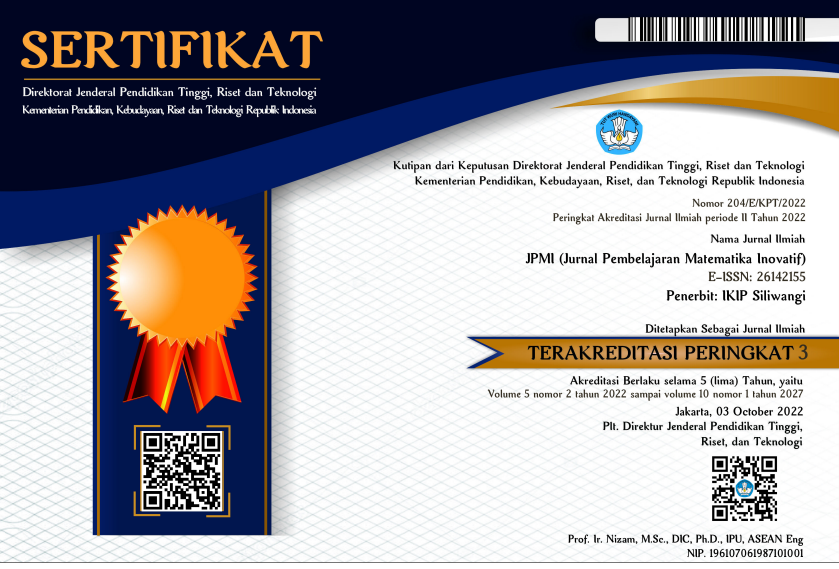PROSES BERPIKIR KREATIF SISWA SMP DALAM MENYELESAIKAN SOAL BILANGAN PECAHAN BERDASARKAN TEORI WALLAS
DOI:
https://doi.org/10.22460/jpmi.v5i6.11941Keywords:
Creative Thinking Process, Fractional Number, Wallas TheoryAbstract
This study aims to describe the creative thinking process of junior high school students who had high, medium and low capability in solving fraction problems based on Wallas theory. The type of this research is descriptive qualitative. The subjects of this research were students of class VII SMP Negeri 18 Serang City which were selected as many as 3 students to represent each category of creative thinking ability. The instruments used in this study were written test questions and interview guidelines. The data analysis technique was carried out in three stages, namely data reduction, data presentation and verification or conclusion drawing. The results showed that students with high ability for the fluency and novelty indicators had been fulfilled until the verification stage, while for the flexibility indicator it is only at the incubation stage. Students with medium ability for the fluency indicator are fulfilled until the verification stage, while for the flexibility indicator it is only at the preparation stage and for the novelty indicator it is fulfilled until the illumination stage. Student with low ability for indicators of fluency and flexibility are only up to the preparation stage while for the novelty indicator does not fulfilled any stage.Â
References
Ahmadi, A. (2013). Psikologi Belajar. Jakarta : Rineka Cipta.
Amalia, A., Sugiatno, & Suratman, D. (2018). Proses Berpikir Kreatif Siswa dalam Menyelesaikan Masalah Bangun Ruang Berdasarkan Tahapan Wallas Di SMP. Jurnal Pendidikan dan Pembelajaran Khatulistiwa, 7(7), 1–10.
Arikunto, S. (2012). Dasar - dasar Evaluasi Pendidikan. Jakarta : Bumi Aksara.
Chan, Z. C. (2013). A Systematic Review of Creative Thinking/Creativity in Nursing Education. Nurse Education Today, 33(11), 1382–1387.
Defitriani, E. (2014). Profil Berpikir Kreatif Siswa Kelas Akselerasi dalam Memecahkan Masalah Matematika Terbuka. Jurnal Ilmiah Matematika dan Pendidikan Matematika, 6(2), 65–76.
Dewi, S. P., & Kartini, K. (2021). Analisis Kesalahan Siswa dalam Menyelesaikan Soal Sistem Persamaan Linear Tiga Variabel berdasarkan Prosedur Kesalahan Newman. Cendekia : Jurnal Pendidikan Matematika, 5(1), 632–642.
Fardah, D. K. (2012). Analisis Proses dan Kemampuan Berpikir Kreatif Siswa dalam Matematika Melalui Tugas Open-Ended. Kreano: Jurnal Matematika Kreatif-Inovatif, 3(2), 91–99. https://doi.org/10.15294/kreano.v3i2.2616
Febriani, S., & Ratu, N. (2018). Profil Proses Berpikir Kreatif Matematis Siswa dalam Pemecahan Masalah Open-Ended Berdasarkan Teori Wallas. Jurnal Mosharafa, 7(1), 39–50.
Ghufron, M. N., & Suminta, R. R. (2010). Teori-teori Psikologi. Yogyakarta : Ar- ruzz Media.
Gie, T. L. (2003). Teknik Berpikir Kreatif (Petunjuk Bagi Mahasiswa Untuk Menjadi Sarjana Unggulan). Yogyakarta : Sabda Persada.
Hines, M., Catalana, S., & Anderson, B. (2019). When Learning Sinks In: Using the Incubations Model of Teaching to Guide Students Through the Creative Thinking Process. Gifted Child Today, 42(1), 36–45.
Khasanah, U., Sunardi, & Sugiarti, T. (2018). Proses Berpikir Kreatif Siswa dalam Memecahkan Soal Cerita Pokok Bahasan SPLDV berdasarkan Tahapan Wallas Ditinjau dari Gaya Belajar. Kadikma, 9(2), 30–38.
Kurniawati, E. Y., & Fatahillah, D. A. (2016). Analisis Pola Berpikir Kreatif Siswa Kelas X IPA 2 SMAN 2 Jember dalam Menyelesaikan Masalah Open-Ended Bangun Datar dan Bangun Ruang. Jurnal EDUKASI, 3(1), 18–23.
Kushendri, K., & Zanthy, L. S. (2019). Analisis Kemampuan Pemecahan Masalah Matematis Siswa SMA. Journal On Education, 1(1), 94–100.
Layn, & Kahar. (2017). Analisis Kesalahan Siswa dalam Menyelesaikan Soal Cerita Matematika. Jurnal Math Educator Nusantara (JMEN), 3(2), 59–145.
Mahmudi, A. (2009). Mengembangkan Kemampuan Berpikir Kreatif Siswa Melalui Pembelajaran Topik Pecahan. Seminar Nasional Aljabar, Pengajaran, dan Terapannya, 1–12.
Novtiar, C., & Aripin, U. (2017). Meningkatkan Kemampuan Berpikir Kritis Matematis dan Kepercayaan Diri Siswa Melalui Pendekatan Open Ended. Jurnal PRISMA, 6(2), 119–131.
Nurwahyuni, Sugiatno, & Ahmad, D. (2020). Potensi Berpikir Kreatif Peserta Didik dalam Pemecahan Masalah Matematis Berdasarkan Teori Wallas Di SMP. Jurnal Pendidikan dan Pembelajaran Khatulistiwa, 9(7), 1–12.
OECD. (2019). PISA 2018 Results (Volume I): What Students Know and Can Do. Paris: OECD Publishing.
Pangestu, N. S., & Yunianta, T. N. H. (2019). Proses Berpikir Kreatif Matematis Siswa Extrovert dan Introvert SMP Kelas VIII Berdasarkan Tahapan Wallas. Mosharafa: Jurnal Pendidikan Matematika, 8(2), 215–226.
Potur, A. A., & Barkul, O. (2009). Gender and Creative Thinking in Education: A theoretical and Experimental Overview. Journal ITU AZ, 6(2), 44–57.
Putri, Y. D. L., Sutriyono, & Pratama, F. W. (2019). Analisis Proses Berpikir Kreatif Siswa Ditinjau dari Gaya Kognitif Berdasarkan Teori Wallas. Jurnal Karya Pendidikan Matematika, 6(1), 71–84.
Sadler-Smith, E. (2015). Wallas’ Four-Stage Model of the Creative Process: More Than Meets the Eye? Creativity Research Journal, 27(4), 342–352.
Saefudin, A. A. (2012). Pengembangan Kemampuan Berpikir Kreatif Siswa dalam Pembelajaran Matematika dengan PMRI. Al-bidayah, 4(1), 37–48.
Sari, S. J., & Yuwono, T. (2020). Kesalahan Siswa dalam Mengerjakan Soal Sistem Persamaan Linear Dua Variabel berdasarkan Kriteria Watson. Jurnal Tadris Matematika, 3(2), 219–228.
Savic, M. (2016). Mathematical Problem-Solving via Wallas’ Four Stages of Creativity: Implications for the Undergraduate Classroom. The Mathematics Enthusiast, 13(3), 255–278.
Siswono, T. Y. E. (2004). Identifikasi Proses Berpikir Kreatif dalam Pengajuan Masalah (Problem Posing) Matematika Berpandu dengan Model Wallas dan Creative Problem Solving (CPS). Buletin Pendidikan Matematika, 6(2), 1–16.
Siswono, T. Y. E. (2008). Model Pembelajaran Matematika Berbasis Pengajuan dan Pemecahan Masalah untuk Meningkatkan Kemampuan Berpikir Kreatif. Surabaya : Unesa University Press.
Tanjung, H. S. (2018). Perbedaan Kemampuan Berpikir Kreatif dan Pemecahan Masalah Matematis Siswa dalam Penerapan Model Pembelajaran Berbasis Masalah. Genta Mulia, 9(1), 110–121.

















